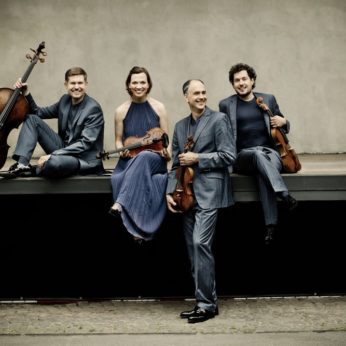Composer: Joseph Haydn (b. 1732 - d. 1809)
Performance date: 26/06/2022
Venue: St. Brendan’s Church
Composition Year: 1772
Duration: 00:24:41
Recording Engineer: Simon Cullen, Ergodos
Instrumentation: 2vn, va, vc
Instrumentation Category:String Quartet
Artists:
Signum Quartet (Florian Donderer, Annette Walther [violins], Xandi van Dijk [viola], Thomas Schmitz [cello]) -
[String Quartet]

Joseph Haydn [1732-1809]
String Quartet in D major Op.20/4 [1772]
1. Allegro di molto
2. Un poco adagio, affetuoso
3. Minuetto, Allegretto alla zingarese
4. Presto e scherzando
This has been the most popular of the Opus 20 quartets. It is also the longest. D major is often regarded as a bright and celebratory key. And although there is brilliance here, the two long movements with which the quartet begins, create a dark and unsettling mood which is not entirely dispelled by the wit and exuberance of the final two movements.
The first movement which is in 3/4 time opens quietly. The opening theme starts with four repeated notes played unison which becomes a kind of leitmotif appearing throughout the movement. This idea is repeated in numerous different ways; sometimes it is played in unison, sometimes as a chord. When it first appears, the repeated note is D but this note changes throughout the quartet. This creates a kind of harmonic instability which contributes to the uneasy mood. The quiet, even sombre tone continues until bar thirty.
Following two beats of silence, the first violin gives a startling arpeggio outburst. The arpeggio is repeated but plays no further part. The movement continues with brief periods of rest, contrasting sudden loud passages with quieter music. Often the first violin plays a running accompaniment over the other instruments. The second subject is more brilliant than the first, with the cello playing an active role. The long development enables Haydn to weave together the quite different opening subjects. The recapitulation is condensed and the movement ends as quietly as it began.
The second movement is a remarkable set of variations in D minor. Until the fourth and final variation, the structure of the movement is based on an eight bar statement followed by a further ten bars of development. Each segment is repeated. This also applies to the solemn and sad opening theme. The first variation is based on syncopation with the second violin and viola providing a running accompaniment. In the second, the cello provides the running accompaniment while this is taken over by the first violin in the third variation which rises to an intense conclusion.
The fourth variation, which is not really a variation at all, begins with a restatement of the original theme and then Haydn adds an extraordinary coda. The music starts quietly; there is a slow crescendo until all four instruments in unison play a rising arpeggio double forte. The music dramatically accelerates alternating soft and loud. After a brief and almost desperate final declaration by the first and second violins, the movement ends pianissimo. The Minuet alla zingarese is as close as Haydn gets to a full on scherzo. The “Hungarian” style of the minuet allows the music to go wild with syncopations and tied notes. Attempting to dance to this would be most unwise.
The finale is a tour de force of brilliance and humour. It opens with a sly cheeky tune which is immediately followed by loud startling chords. These are not to be taken seriously. All the instruments echo and reply to each other in unison, in pairs and solo. The movement is in sonata form. Haydn only uses rondos for his finales later in his career. But this does not stop this movement from having all the exuberant circularity of a rondo. In the final bars, the music slows and the movement ends quietly. It’s as though, by ending the quartet in this way, Haydn does not want the high spirits of his finale entirely to distract from the grander, darker music that has gone before.
David Winter
Copyright © 2025 West Cork Music. All rights reserved.
Designed and developed by Matrix Internet